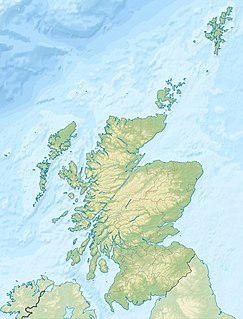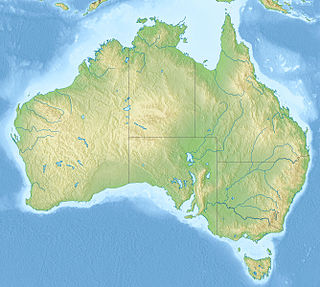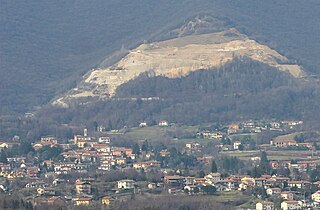 W
WThe Allgäu Formation is a geologic formation in Austria. It preserves fossils dating back to the Hettangian to Sinemurian stages of the Early Jurassic period, or Raricostatum to Obtusum in the regional stratigraphy. Initially and formally defined by Jacobshagen (1965). The Allgäu Formation is formerly known as spotted marls (Lias-Fleckenmergel) and spotted marly limestones (Fleckenkalk). The formation is represented by dark-grey bioturbated limestones and marlstone interbeds. It represents basinal hemipelagic facies common in Alpine Tethys regions of Alps, Carpathians and other mountain ranges. Several horizons of the formation are particularly rich in ammonite fauna.
 W
WThe Bagå Formation is a geological formation dating to around 199 to 170 million years ago, in the Early and Late Jurassic. It is located on the island of Bornholm, Denmark.
 W
WThe Boonton Formation is a mapped bedrock unit in New Jersey, formerly divided between the Boonton and Whitehall beds of the defunct Brunswick Formation. It is named for the town of Boonton, New Jersey, which is near where its type section was described by paleontologist Paul E. Olsen.
 W
WThe Broadford Beds Formation is a Sinemurian geologic formation in western Scotland. An indeterminate partial tibia of a theropod dinosaur are among the fossils that have been recovered from the formation
 W
WThe Bushveld Sandstone is a geological formation dating to roughly between 201 and 189 million years ago and covering the Carnian to Norian stages. The Bushveld Sandstone is found in Transvaal, South Africa and is a member of the Stormberg Group. As its name suggests, it consists mainly of sandstone. Fossils of the prosauropod dinosaur Massospondylus have been recovered from the Bushveld Sandstone.
 W
WThe Charmouth Mudstone Formation is a geological formation in England. It preserves fossils dating back to the early part of the Jurassic period (Sinemurian–Pliensbachian). It forms part of the lower Lias Group. It is most prominently exposed at its type locality in cliff section between Lyme Regis and Charmouth but onshore it extends northwards to Market Weighton, Yorkshire, and in the subsurface of the East Midlands Shelf and Wessex Basin. The formation is notable for its fossils, including those of ammonites and marine reptiles and rare dinosaur remains. The formation played a prominent role in the history of early paleontology, with its Lyme Regis-Charmouth exposure being frequented by fossil collectors including Mary Anning.
 W
WThe Clarens Formation is a geological formation found in several localities in Lesotho and in the Free State, KwaZulu-Natal, and Eastern Cape provinces in South Africa. It is the uppermost of the three formations found in the Stormberg Group of the greater Karoo Supergroup rocks and represents the final phase of preserved sedimentation of the Karoo Basin.
 W
WThe Fernie Formation is a stratigraphic unit of Jurassic age. It is present in the western part of the Western Canada Sedimentary Basin in western Alberta and northeastern British Columbia. It takes its name from the town of Fernie, British Columbia, and was first defined by W.W. Leach in 1914.
 W
WThe Forest Sandstone is a geological formation in southern Africa, dating to roughly between 200 and 190 million years ago and covering the Hettangian to Sinemurian stages of the Jurassic Period in the Mesozoic Era. As its name suggests, it consists mainly of sandstone.
 W
WThe Hanson Formation is a geologic formation on Mount Kirkpatrick, Antarctica. It is one of only two major dinosaur-bearing rock groups found on the continent of Antarctica to date; the other is the Snow Hill Island Formation and related formations from the Late Cretaceous of the Antarctic Peninsula. The formation has yielded only a handful of Mesozoic specimens so far and most of it is as yet unexcavated. Part of the Victoria Group of the Transantarctic Mountains, it is below the Prebble Formation and above the Falla Formation. The Formation is related to the Volcanic Activity Linked to the Karoo-Ferar eruptions on the Lower Jurassic. The climate of the zone was similar to the modern Southern Chile, Humid, with a temperature interval of 17–18 degrees.
 W
WThe Imi-n-Ifri Formation is a Sinemurian geologic formation outcropping about 6 kilometres (3.7 mi) from Demnate, to the east of Marrakech, Morocco. Fossil ornithopod tracks have been reported from the formation.
 W
WThe Kota Formation is a geological formation in India. The precise age of Kota Formation are uncertain, but it dates from the Early to Middle Jurassic, and is split into a Lower Member and Upper Member. The lower member is thought to be Hettangian-Pliensbachian. While the upper unit is thought to be Toarcian, but may possibly extend into the Aalenian. It conformably overlies the Dharmaram Formation which is Late Triassic to earliest Jurassic and is unconformably overlain by the Early Cretaceous Gangapur Formation. The lower member is approximately 100 m thick while the upper member is 490 m thick. Both subunits primarily consist of mudstone and sandstone, but near the base of the upper unit there is a 20-30 metre thick succession of limestone deposited in a freshwater setting.
 W
WThe Lufeng Formation is a Lower Jurassic sedimentary rock formation found in Yunnan, China. It has two units: the lower Dull Purplish Beds/Shawan Member are of Hettangian age, and Dark Red Beds/Zhangjia'ao Member are of Sinemurian age. It is known for its fossils of early dinosaurs. The Dull Purplish Beds have yielded the possible therizinosaur Eshanosaurus, the possible theropod Lukousaurus, and the "prosauropods" "Gyposaurus" sinensis, Lufengosaurus, Jingshanosaurus, and Yunnanosaurus. Dinosaurs discovered in the Dark Red Beds include the theropod Sinosaurus triassicus, the "prosauropods" "Gyposaurus", Lufengosaurus, and Yunnanosaurus, indeterminate remains of sauropods, and the early armored dinosaurs Bienosaurus and Tatisaurus.
 W
WThe Luxembourg Sandstone is a geologic formation in Luxembourg. It exists along the eastern margin of the Paris Basin. Sandstone units continuous with the Luxembourg Sandstone also occur in France. It is Early Jurassic in age. It predominantly outcrops in a belt extending through south-central Luxembourg. It up to 100 metres thick and predominantly consists of carbonaceuous poorly cemented sandstone and sandy limestone
 W
WThe Mecsek Coal Formation is a Jurassic geologic formation in Hungary. Indeterminate fossil ornithischian tracks have been reported from the formation.
 W
WThe Moltrasio Formation also known as Lombardische Kieselkalk Formation is a geological formation in Italy. This Formation mostly developed on the Lower ot Middle Sinemurian stage of the Lower Jurassic, where on the Lombardian basin tectonic activity modified the current marine and terrestrial habitats. Here it was developed a series of marine-related depositional settings, represented by an outcrop of 550–600 m of grey Calcarenites and Calcilutites with chert lenses and marly interbeds, that recovers the Sedrina, Moltrasio and Domaro Formations. This was mostly due to the post-Triassic crisis, that was linked locally to tectonics. The Moltrasio Formation is considered a continuation of the Sedrina Limestone and the Hettangian Albenza Formation, and was probably a shallow water succession, developed on the pasive margin of the westernmost Southern Alps. It is known due to the exquisite preservation observed on the Outcrop on Osteno, where several kinds of marine biota have been recovered.
 W
WThe Navajo Sandstone is a geological formation in the Glen Canyon Group that is spread across the U.S. states of southern Nevada, northern Arizona, northwest Colorado, and Utah as part of the Colorado Plateau province of the United States.
 W
WThe Noreán Formation is a geological formation of the Eastern Ranges of the Colombian Andes, the Serranía de San Lucas and as basement underlying the southernmost Lower and northern Middle Magdalena Valleys. The formation consists of volcanic and pyroclastic lavas that range from andesites to rhyolites. Vitric, lithic and crystal tuffs and andesitic dikes and hypabyssal bodies are also present in the formation.
 W
WThe Nugget Sandstone is a Late Triassic to Early Jurassic geologic formation that outcrops in Colorado, Idaho and Utah, western United States. Fossil theropod tracks have been reported from the formation.
 W
WThe Razorback Beds is an Early Jurassic geologic formation in Queensland, Australia. Fossil ornithopod tracks have been reported from the formation.
 W
WThe Redcar Mudstone Formation is a geological formation in North Yorkshire, England. Part of the Lias Group, it was deposited in the Hettangian to Pliensbachian stages of the Early Jurassic. The lithology consists of fissile mudstones and siltstones, with the lower part having thin beds of limestone and the upper part having thin beds of sandstone.
 W
WThe Rya Formation is a geologic formation in Skåne County, southern Sweden. It is Early to early Middle Jurassic in age. The Rya Formation comprises siltstones, claystones, sandstones, mudstones and rare coal beds. The formation overlies the Höganäs Formation and is overlain by the Vilhelmsfält and Mariedal Formations.
 W
WThe Saltrio Formation is a geological formation in Italy. It dates back to the middle Sinemurian, and would have represented a pelagic or near-epicontinental environment, judging by the presence of marine fauna such as the nautiloid Cenoceras. The Fossils of the Formation were described on the late 1880s and revised on 1960s, finding first marine biota, such as Crinoids, Bivalves and other fauna related to Epicontinental basin deposits.
 W
WThe Scunthorpe Mudstone is a geologic formation in England. It preserves plesiosaur fossils dating back to the Late Triassic (Rhaetian) to Early Jurassic (Hettangian) period. It predominantly consists of grey mudstone with thin beds of argillaceous limestone and calcareous siltstone. The Ichthyosaur Wahlisaurus is known from the formation. As is the holotype specimen of the dinosaur Sarcosaurus.
 W
WThe Talkeetna Formation is a geologic formation in Alaska. It preserves fossils dating back to the Early Jurassic period.
 W
WThe Upper Dharmaram Formation is an Early Jurassic geologic formation found in Andhra Pradesh, India. It is of Sinemurian age, and dinosaur remains are among the fossils that have been recovered from the formation.